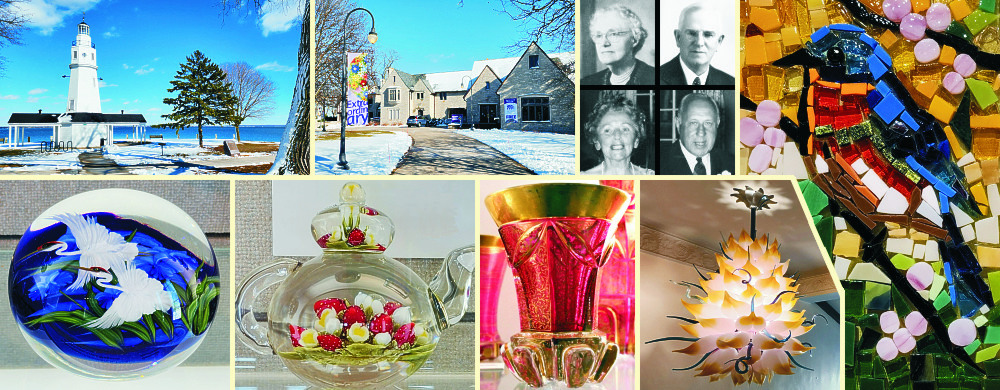Kansas Snapshots by Gloria Freeland - March 28, 2025
For the love of glass
If you're not a big fan of the Green Bay Packers, cheese, bratwurst, or cold winters, you may think you have no connection to
Wisconsin. But you'd be wrong if you’ve ever reached for a Kleenex tissue or a sheet of Cottonelle toilet paper, trained a youngster
using Huggies diapers, wiped up a mess with a Viva or Scott towel, or used a Kotex product. These are just a few of the recognizable
names of a large Wisconsin-shaped industry based on a product largely taken for granted - paper.
With an abundance of water and trees, the state had hundreds of paper mills by the end of the 19th century. And for years, it was an
industry that was largely recession-proof. A common expression was "whether you write with black ink or red ink, you still need the
paper to write on." Husband Art's uncle was the president of a mill for a number of years.
This history became familiar to me after Art and I married 37 years ago and we began making frequent trips to the Badger State.
We were there just last week when a several-inch early-spring snow blanketed Art's hometown of Appleton. But it receded quickly when
temperatures rose into the 40s the following day. We took advantage to explore a bit of the legacy of that paper-making industry.
Lake Winnebago is a 10-mile-wide by 30-mile-long body of water that begins at Appleton's southern extreme. We stopped to take some
pictures on Neenah Point, a finger of land with a lighthouse that juts out into the lake. A plaque explained that the point had been
deeded to the city of Neenah in 1929 for a public park. The donor was Helen Kimberly Stuart - as in the Kimberly-Clark company, the
folks who manufacture all of those products previously mentioned. Her brother James Kimberly gave the lighthouse.
The white snow against a deep-blue sky and the even deeper-blue lake created a winter wonderland. It was cold, but people were
jogging, walking their dogs, or just strolling along the shore's edge. The people in those climes seem to have thicker blood than
I do.
About half a block from the tip in a perfect setting was a large Tudor home - now the Bergstrom-Mahler Museum of Glass.
We were wowed by the different varieties of glass art work - paperweights, Germanic drinking vessels, and
Victorian-era-to-contemporary decorative sculptures. The sun streaming in the windows and the display lighting made the glass
shimmer.
Among my favorites were the paperweights with dahlias, irises, poinsettias and other flowers. There were quirky ones too, including
a cowboy on a horse and a blue frog. Art said he had no idea people could be so interested in paperweights.
Evangeline frequently wintered in Florida. While there in 1935, she acquired what museum staff members believe was her first
paperweight - one similar to her grandmother's. It was dated 1847 and had a "B," which stood for Baccarat, a well-known French
crystal maker.
She soon became an expert in antique paperweights. Her collection was exhibited at The Art Institute of Chicago in 1939 and at the
Milwaukee Art Institute in 1940. She wrote a book, "Old Glass Paperweights," using information from her own collection and her
research.
In 1914, scientist Ernst Mahler, who grew up in Vienna, Austria, emigrated to the U.S. and took a position with Kimberly-Clark
Corporation in Neenah. He developed the process of making cellu-cotton, a material virtually identical to ordinary cotton, but made
from processed wood. It was used in World War I bandages and later adapted to feminine hygiene products and disposable diapers.
But it was his purchase of a Germanic glass collection - known as the Kurz Collection - for his wife Carol that would be critical
to the eventual formation of the glass museum
The Bergstroms had no children, so when John died in June 1951, he left a substantial sum of money to the City of Neenah to be used
for a museum. Two years later, Evangeline gave the Tudor mansion they had built in 1929-‘30 to serve as a museum site. The Mahlers,
having developed into enthusiastic supporters of glass figures, became board members of the glass museum. On April 5, 1959, the John
Nelson Bergstrom Art Center opened to the public.
Today, the Bergstrom-Mahler Museum of Glass has more than 5,000 objects and is ranked as one of the top glass museums in the country,
hosting more than 20,000 visitors annually.
It also has displays of tools and shows the processes used by glass artists of today and yesterday.
The museum isn't just a static display of old objects. A current exhibit is "Teen Voices in Glass," which features the work of
students and their teachers from 15 area high schools. The museum also holds classes. According to glass studio manager Taylor
Moeller-Roy, the museum provides workshops in glass fusing, flameworking, glass blowing, and other related specialties. She
draws inspiration from various seasons and holidays, including hosting "Pride" flag classes in June, Christmas-in-July ornament
classes, and summer workshops for garden/yard art.
The museum seamlessly connects the Bergstrom and Mahler families' role in Wisconsin's paper industry with their love of glass. It's
well worth a visit - and the price is right - free.

